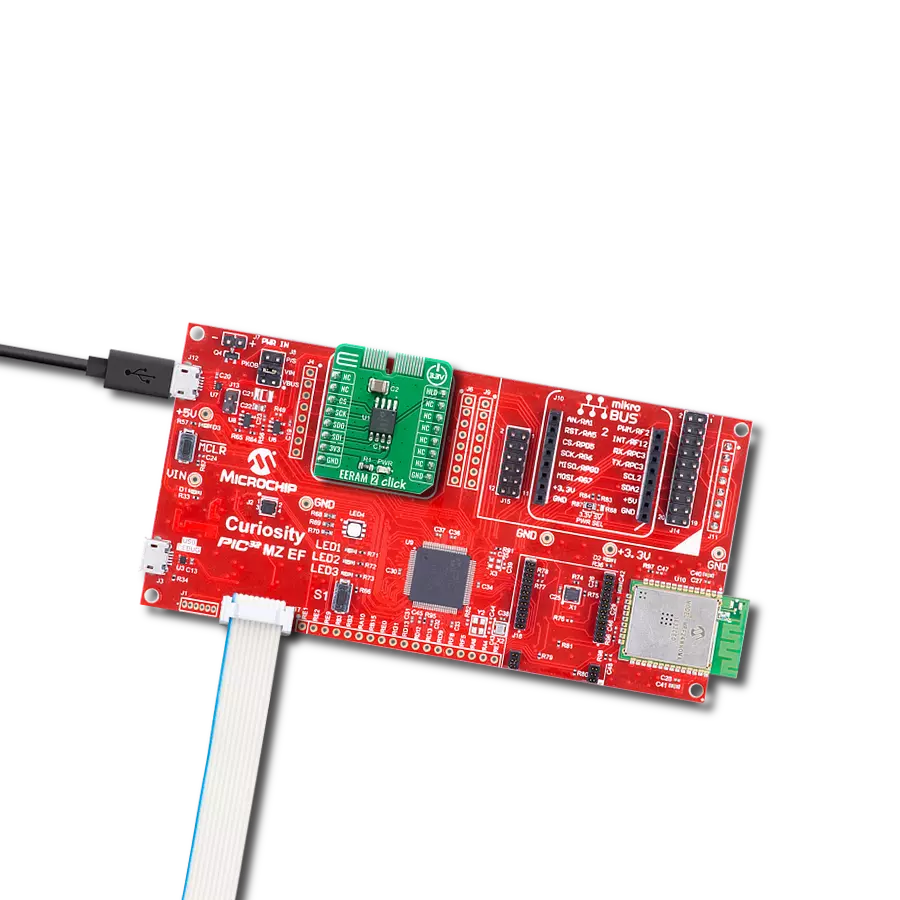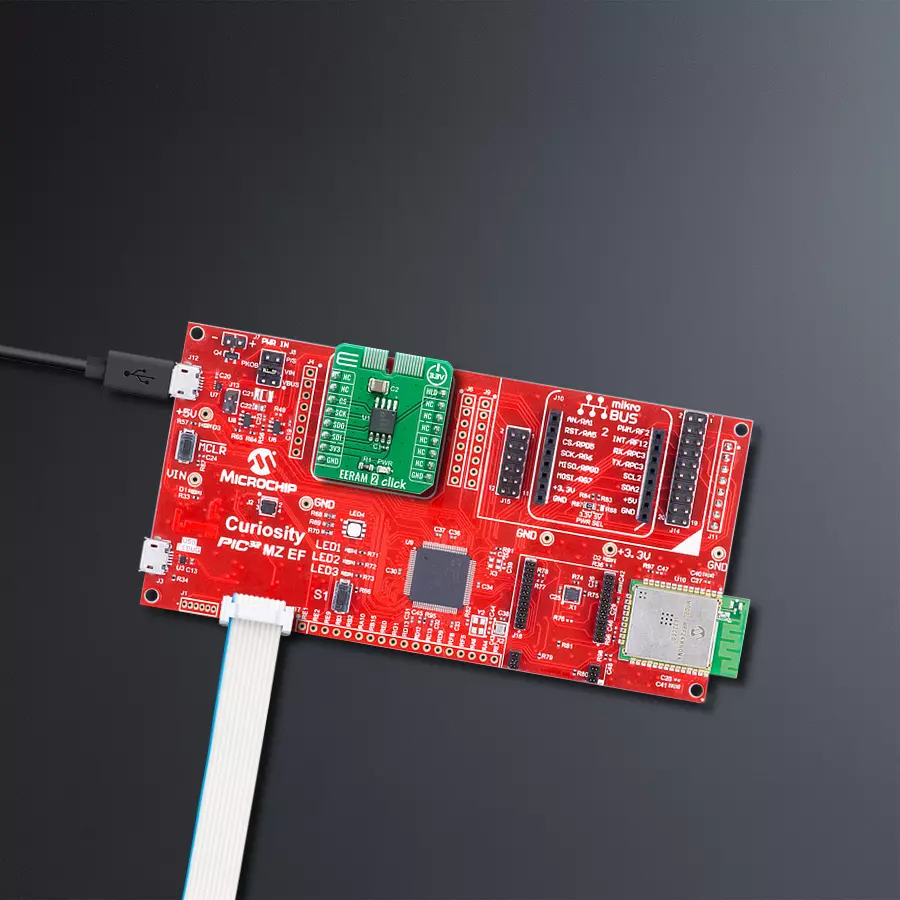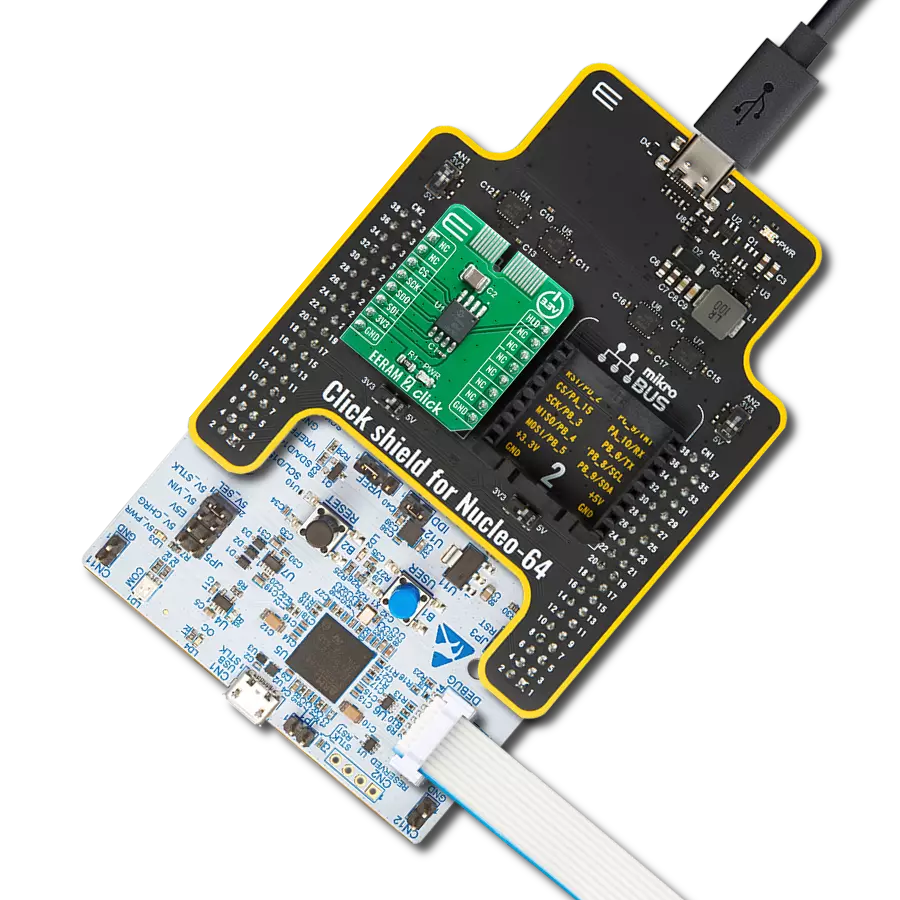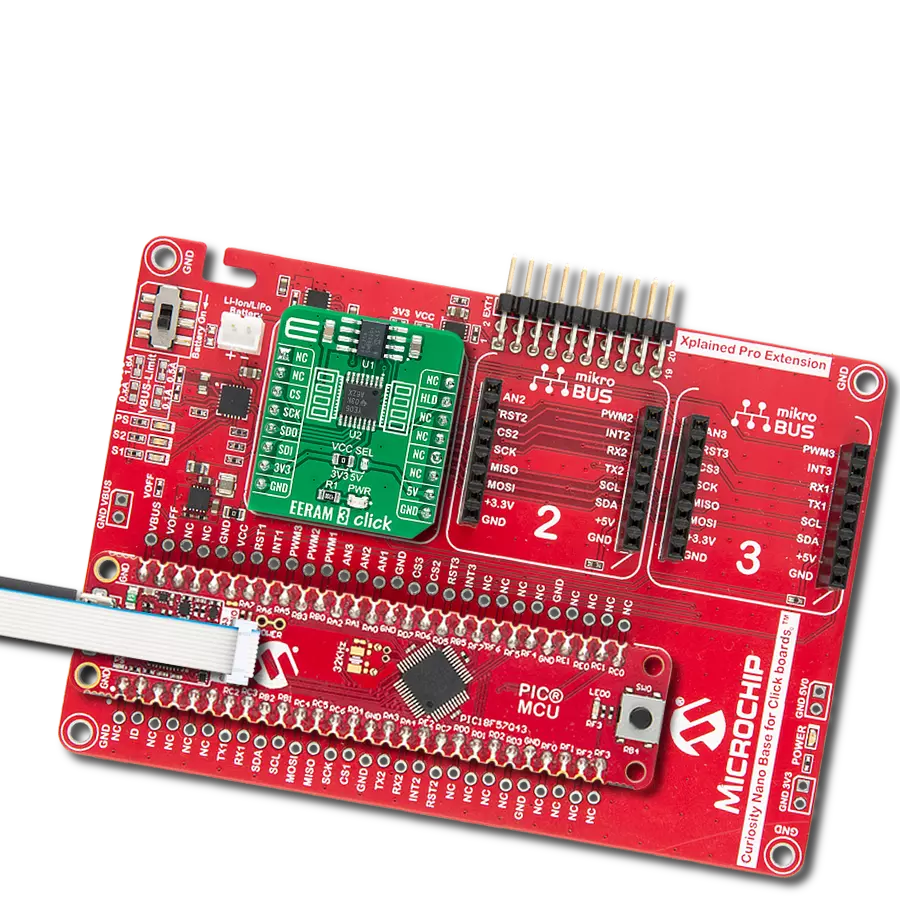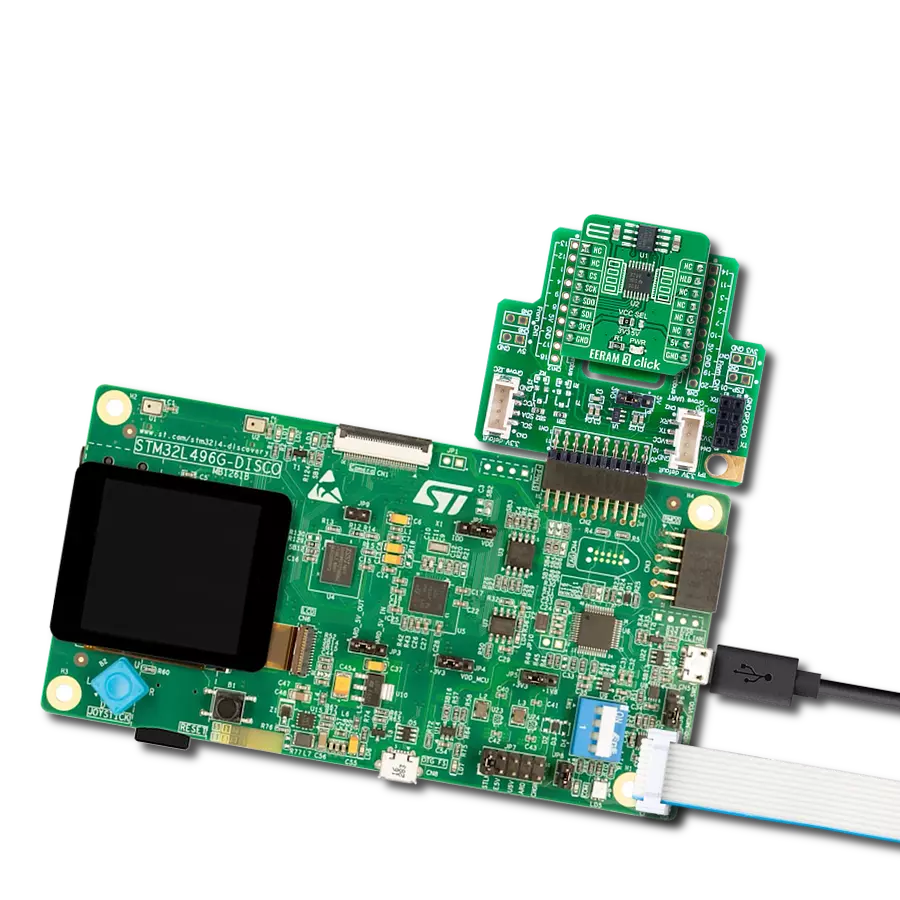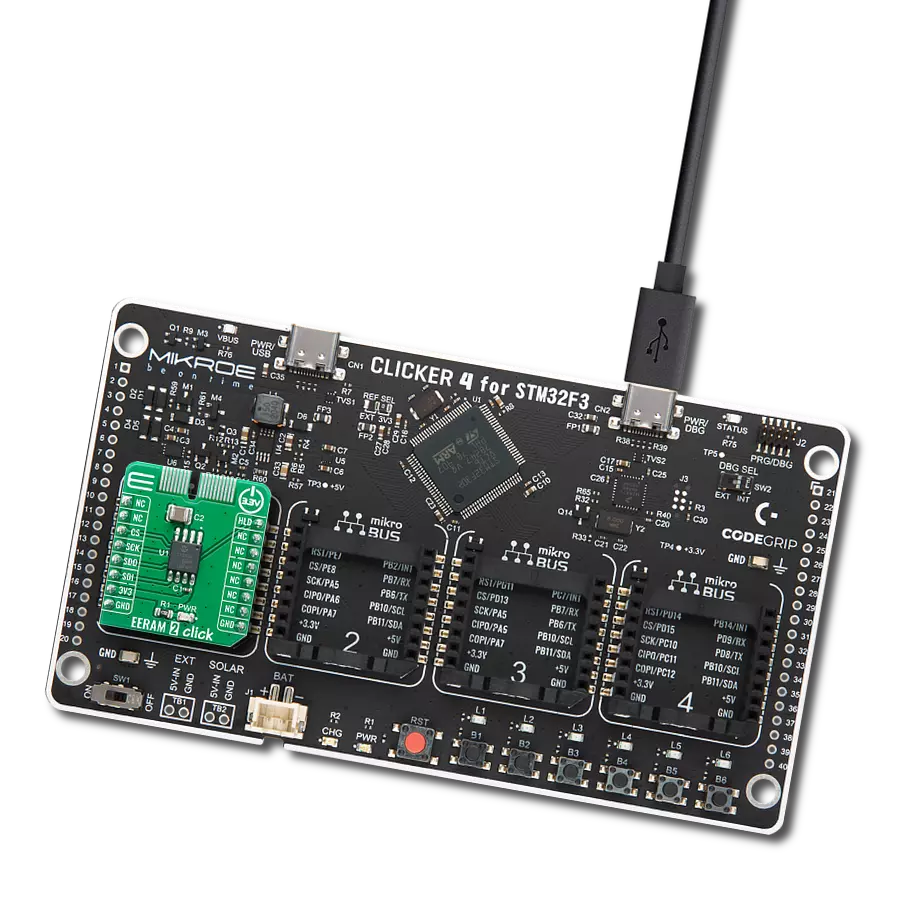Utilize serial EERAM in industrial machinery and automation systems, allowing quick recovery from power interruptions and ensuring minimal downtime and smooth operational continuity
A
A
Hardware Overview
How does it work?
EERAM 2 Click is based on the 48LM01, a 1024-Kbit SRAM with EEPROM backup in each memory cell from Microchip. The user can treat this device as a full symmetrical read/write SRAM with no limits on cell usage. The device handles backup to EEPROM on any power disruption, so the user can effectively view this device as an SRAM that never loses its data. The SRAM is organized as 131,072 x 8 bits with access via the SPI serial interface. The backup EEPROM is invisible and cannot be accessed by the user independently. The 48LM01 includes circuitry that detects VCC dropping below a certain threshold, shuts its connection to the outside environment, and transfers all SRAM data to the EEPROM portion of each cell for safekeeping. When VCC returns, the circuitry automatically returns the data to the SRAM, and the user’s interaction with the SRAM can continue with the same data set. When power is first
applied to the click board™, the VCAP capacitor is charged to VCC through the 48LM01 IC. During normal SRAM operation, the capacitor remains charged, and the device monitors the level of system VCC. If the system VCC drops below a set threshold, the device interprets this as a power-off or brown-out event. The device suspends all I/O operation, shuts off its connection with the VCC pin, and uses the saved energy in the capacitor to power the device through the VCAP pin as it transfers all SRAM data to EEPROM. On the next power-up of VCC, the data is transferred back to SRAM, the capacitor is recharged, and the SRAM operation continues. Besides standard 4-wire SPI lines, 48LM01 has an additional HOLD pin. This pin can be used for transmission suspension to the 48LM01 while in the middle of a serial sequence without retransmitting the entire sequence. It must be held high any time this function is not
being used. Once the device is selected and a serial sequence is underway, the HOLD pin may be pulled low to pause further serial communication without resetting the serial sequence. The 48LM01 is internally organized as a continuous SRAM array for reading and writing, along with a non-volatile EEPROM array that is not directly accessible to the user but can be refreshed or recalled on power cycles or software commands. The SRAM array is continuously addressable, so the entire array can be written without accessing pages. This Click board™ can be operated only with a 3.3V logic voltage level. The board must perform appropriate logic voltage level conversion before using MCUs with different logic levels. Also, it comes equipped with a library containing functions and an example code that can be used, as a reference, for further development.
Features overview
Development board
Curiosity PIC32 MZ EF development board is a fully integrated 32-bit development platform featuring the high-performance PIC32MZ EF Series (PIC32MZ2048EFM) that has a 2MB Flash, 512KB RAM, integrated FPU, Crypto accelerator, and excellent connectivity options. It includes an integrated programmer and debugger, requiring no additional hardware. Users can expand
functionality through MIKROE mikroBUS™ Click™ adapter boards, add Ethernet connectivity with the Microchip PHY daughter board, add WiFi connectivity capability using the Microchip expansions boards, and add audio input and output capability with Microchip audio daughter boards. These boards are fully integrated into PIC32’s powerful software framework, MPLAB Harmony,
which provides a flexible and modular interface to application development a rich set of inter-operable software stacks (TCP-IP, USB), and easy-to-use features. The Curiosity PIC32 MZ EF development board offers expansion capabilities making it an excellent choice for a rapid prototyping board in Connectivity, IOT, and general-purpose applications.
Microcontroller Overview
MCU Card / MCU
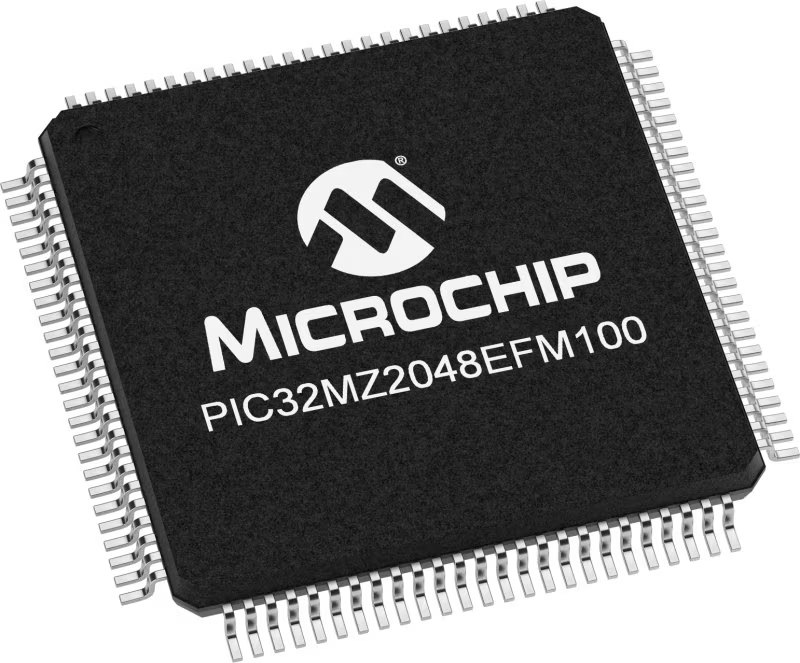
Architecture
PIC32
MCU Memory (KB)
2048
Silicon Vendor
Microchip
Pin count
100
RAM (Bytes)
524288
Used MCU Pins
mikroBUS™ mapper
Take a closer look
Click board™ Schematic

Step by step
Project assembly
Track your results in real time
Application Output
1. Application Output - In Debug mode, the 'Application Output' window enables real-time data monitoring, offering direct insight into execution results. Ensure proper data display by configuring the environment correctly using the provided tutorial.

2. UART Terminal - Use the UART Terminal to monitor data transmission via a USB to UART converter, allowing direct communication between the Click board™ and your development system. Configure the baud rate and other serial settings according to your project's requirements to ensure proper functionality. For step-by-step setup instructions, refer to the provided tutorial.

3. Plot Output - The Plot feature offers a powerful way to visualize real-time sensor data, enabling trend analysis, debugging, and comparison of multiple data points. To set it up correctly, follow the provided tutorial, which includes a step-by-step example of using the Plot feature to display Click board™ readings. To use the Plot feature in your code, use the function: plot(*insert_graph_name*, variable_name);. This is a general format, and it is up to the user to replace 'insert_graph_name' with the actual graph name and 'variable_name' with the parameter to be displayed.

Software Support
Library Description
This library contains API for EERAM 2 Click driver.
Key functions:
eeram2_set_on_hold_status- Set On-hold status functioneeram2_set_command- Set command functioneeram2_set_write_status- Set write status function
Open Source
Code example
The complete application code and a ready-to-use project are available through the NECTO Studio Package Manager for direct installation in the NECTO Studio. The application code can also be found on the MIKROE GitHub account.
/*!
* \file
* \brief Eeram2 Click example
*
* # Description
* This example demonstrates the use of EERAM 2 Click board.
*
* The demo application is composed of two sections :
*
* ## Application Init
* Initializes the driver and enables the Click board.
*
* ## Application Task
* Writes a desired number of bytes to the memory and then verifies if it is written correctly
* by reading from the same memory location and displaying its content on the USB UART.
*
* \author MikroE Team
*
*/
// ------------------------------------------------------------------- INCLUDES
#include "board.h"
#include "log.h"
#include "eeram2.h"
// ------------------------------------------------------------------ VARIABLES
static eeram2_t eeram2;
static log_t logger;
static char demo_data[ 9 ] = { 'M', 'i', 'k', 'r', 'o', 'E', 13 ,10 , 0 };
static char read_data[ 9 ];
static uint8_t check_status;
// ------------------------------------------------------ APPLICATION FUNCTIONS
void application_init ( void )
{
log_cfg_t log_cfg;
eeram2_cfg_t cfg;
/**
* Logger initialization.
* Default baud rate: 115200
* Default log level: LOG_LEVEL_DEBUG
* @note If USB_UART_RX and USB_UART_TX
* are defined as HAL_PIN_NC, you will
* need to define them manually for log to work.
* See @b LOG_MAP_USB_UART macro definition for detailed explanation.
*/
LOG_MAP_USB_UART( log_cfg );
log_init( &logger, &log_cfg );
log_info( &logger, "---- Application Init ----" );
// Click initialization.
eeram2_cfg_setup( &cfg );
EERAM2_MAP_MIKROBUS( cfg, MIKROBUS_1 );
eeram2_init( &eeram2, &cfg );
eeram2_set_on_hold_status( &eeram2, EERAM2_HOLD_DISABLE );
Delay_ms ( 100 );
eeram2_set_write_status( &eeram2, EERAM2_WRITE_ENABLE );
Delay_ms ( 100 );
}
void application_task ( void )
{
check_status = eeram2_write_continuous( &eeram2, 0x00543210, &demo_data[ 0 ], 9 );
if ( check_status == EERAM2_ERROR )
{
log_printf( &logger, " ERROR Writing \r\n" );
log_printf( &logger, "--------------------\r\n" );
for ( ; ; );
}
log_printf( &logger, " Writing... \r\n" );
log_printf( &logger, "--------------------\r\n" );
Delay_ms ( 100 );
check_status = eeram2_read_continuous( &eeram2, 0x00543210, &read_data[ 0 ], 9 );
if ( check_status == EERAM2_ERROR )
{
log_printf( &logger, " Reading ERROR \r\n" );
log_printf( &logger, "--------------------\r\n" );
for ( ; ; );
}
log_printf( &logger, " Read data : %s", read_data );
log_printf( &logger, "--------------------\r\n" );
Delay_ms ( 1000 );
}
int main ( void )
{
/* Do not remove this line or clock might not be set correctly. */
#ifdef PREINIT_SUPPORTED
preinit();
#endif
application_init( );
for ( ; ; )
{
application_task( );
}
return 0;
}
// ------------------------------------------------------------------------ END
